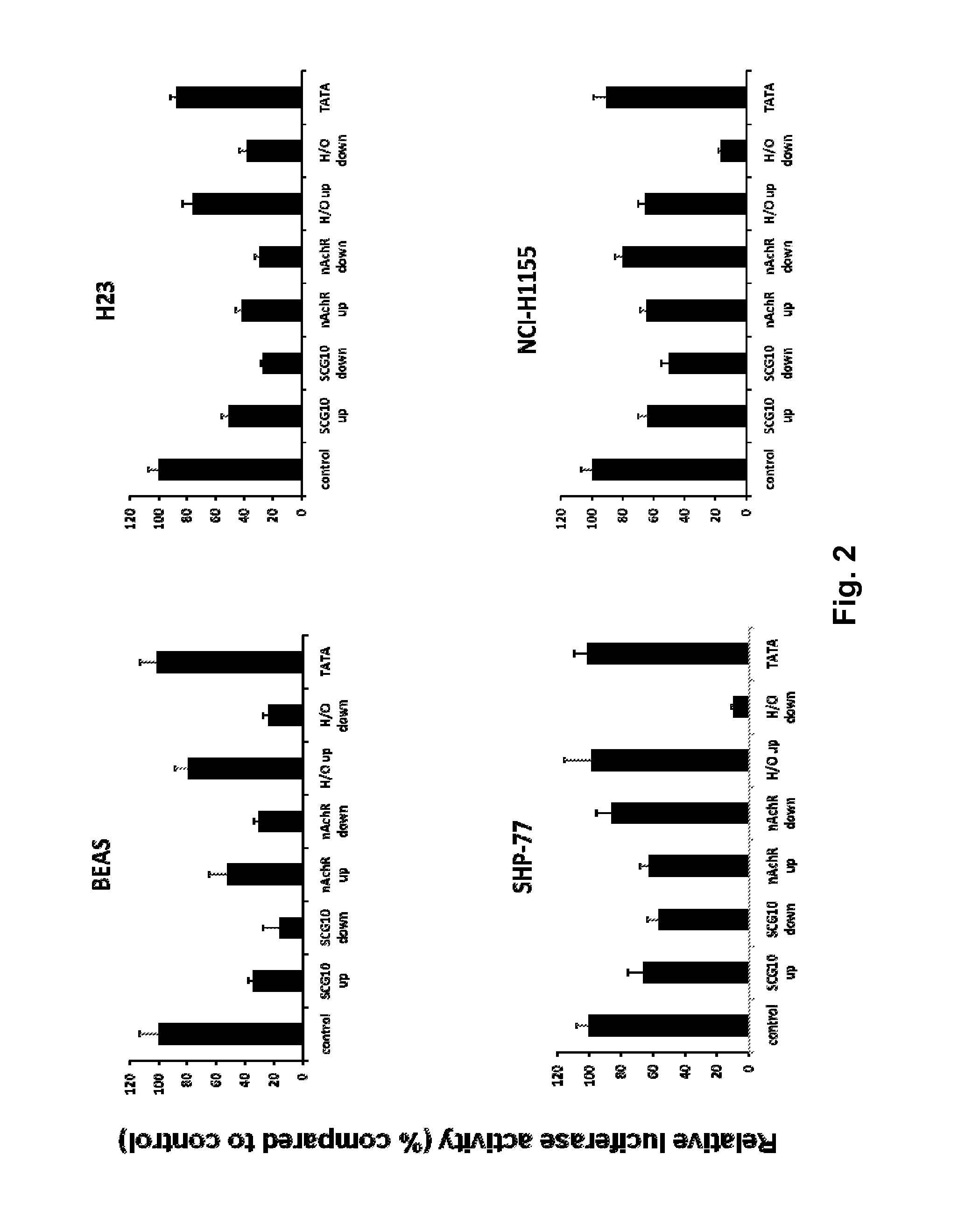Modified INSM1-Promoter for Neuroendocrine Tumor Therapy and Diagnostics
a neuroendocrine tumor and promoter technology, applied in the direction of peptide sources, dsdna viruses, drug compositions, etc., can solve the problems of liver being the most susceptible to toxic side effects, host-mediated immunity of adenoviruses, etc., to increase the safety of transcriptionally regulated suicide gene therapy, increase the effect of use and safety
- Summary
- Abstract
- Description
- Claims
- Application Information
AI Technical Summary
Benefits of technology
Problems solved by technology
Method used
Image
Examples
example 1
[0029]Materials and Methods
[0030]Modifications to the INSM1 promoter region. To functionally test the effect of inclusion of various neuronal specific DNA elements to the INSM1 promoter activity, all the constructs were compared in the pGL3 or pGL4 luciferase reporter vector (Promega Corp., Madison, Wis.). The human INSM1 promoter developed by one of the inventors (Dr. M. S. Lan) from nucleotides −1661 to +40 bp was subcloned into the Sma I site of the pGL3 Basic vector. Proper orientation of the INSM1 promoter region was confirmed by restriction endonuclease digestion as described (13). The unmodified INSM1 promoter-luciferase construct was used as the control vector for all comparisons. To modify the promoter region, two tandem copies of the neuronal restrictive silencer element (NRSE) derived from either the superior cervical ganglion 10 (SCG10) or nicotinic acetylcholine receptor (nAchR) promoter regions were synthesized (Eurofins MWG Operon, Huntsville, Ala.) and cloned either ...
example 2
[0041]Effect of Modification of INSM1 Promoter Region with NRSEs in Non-INSM1 Expressing Cells
[0042]The existing INSM1 promoter region has been modified to incorporate DNA elements from other tissue selective genes that have silenced expression of neuronal genes in non-neuronal cells. The first modification of the existing INSMI promoter region was addition of two tandem copies of the neuronal restrictive silencer elements (NRSEs) derived from the mouse nicotinic acetylcholine receptor (nAChR) or the rat superior cervical ganglion 10 (SCG10) promoters either directly upstream or downstream of the INSM1 promoter sequence. The NRSE elements when bound by the cognate protein, the neuron restrictive silencing factor, NRSF, can strongly repress transcription in non-neuronal cells as well as allow transcription of the same gene in neuronal cells. Transient transfection for comparison between the wild type 1.7 kbp INSM1 promoter with the SCG10 up or down, or n(AchR) up or down modification...
example 3
[0047]Effect of Modification of INSM1 Promoter Region with NRSEs in INSM1 Expressing Cells
[0048]The effect of the modified INSM1 promoter on INSM1 expressing cell lines was determined to see if the changes negatively affect the promoter in target cell types. One of the most prevalent and aggressive forms of neuroendocrine tumors is small cell lung cancer (SCLC). To assess the effect of the NRSE modifications on promoter activity, transient transfections were performed in a “normal” human bronchial epithelial cell line, BEAS, a human lung adenocarcinoma cell line, NCI-H23, and two human SCLC cell lines SHP-77 and NCI-H1155. In these four cell lines, the control INSM1 promoter luciferase construct was compared with the modified promoter constructs. All transient transfections were normalized with TK-renilla and performed in triplicate on three separate occasions. Luciferase activity was assessed using the Dual-Glo luciferase reagent (Promega). The results are shown in FIG. 2.
[0049]In ...
PUM
| Property | Measurement | Unit |
|---|---|---|
| volume | aaaaa | aaaaa |
| insulator | aaaaa | aaaaa |
| size | aaaaa | aaaaa |
Abstract
Description
Claims
Application Information
 Login to View More
Login to View More - R&D
- Intellectual Property
- Life Sciences
- Materials
- Tech Scout
- Unparalleled Data Quality
- Higher Quality Content
- 60% Fewer Hallucinations
Browse by: Latest US Patents, China's latest patents, Technical Efficacy Thesaurus, Application Domain, Technology Topic, Popular Technical Reports.
© 2025 PatSnap. All rights reserved.Legal|Privacy policy|Modern Slavery Act Transparency Statement|Sitemap|About US| Contact US: help@patsnap.com



